I Dig Sports

It is the 25th over of the chase. Kane Williamson has caressed his way to 45 off 56. It is a slow pitch where every batsman has struggled because of the dual pace, but he has been smoother than the others. Lungi Ngidi runs in, Williamson punches sweetly again, but he hits straight to mid-off. Two balls later, another punch-drive, straight to mid-off again. Imran Tahir bowls the next over. A superb dive from Aiden Markram at cover denies Williamson runs. Williamson sweeps next ball, finds short fine this time.
Very rarely do you see a batsman of Williamson's skill hit the fielders four times in a row. "They were coming out of the middle too, which is seemingly enjoyable," he even says. Yet he is struggling with the placement. The problem is the team is four wickets down, South Africa are bowling straight lines, and he knows if he opens the face or hits across the line to try to find the gap, he is taking a risk because of the conditions. Jimmy Neesham, at the other end, is facing similar issues. The asking rate has gone from 5.42 to 6 in four overs, but the ESPNcricinfo forecaster has actually increased their chances of winning from 42.11% to 43.08%.
Williamson doesn't need a forecaster to tell him that. His mind has one. Four good shots for no run, eight straight dots, but he takes a calm single next ball. Not thinking of the possible 16 runs missed, but the 60 to get that can take New Zealand through. This is a master at work. In the 27th over, he hits what looks like million-dollar drives straight to mid-off and mid-on, but he is not anxious.
WATCH on Hotstar (India only) - Williamson's century
By the 30th over, the asking rate has gone up to 6.26, but the forecaster has taken them to a 55.24% chance of winning. However, Williamson is now reaching a slightly more urgent stage of the innings. He is going to target Andile Phehlukwayo because Kagiso Rabada is getting extra bounce to go with the slowness in the pitch. The whole 30th over is full of frustration. He hits straight to point, he mis-hits one to mid-off. He takes a break, walks to Neesham, knocks gloves, refocuses. The next ball he tries a pull, and the ball squeezes under the bat. He goes down, knocks the pitch with his bat. The next bottom edge narrowly evades the stumps.
When he is finding the timing, he is struggling to place the ball; when he is trying to place the ball, timing has deserted him. The internal forecaster is working. It is telling him it is all down to him. When Neesham's wicket will fall in the 33rd over, the forecaster will fall down from backing them 65.9% to 48.5% in one ball. Imagine if Williamson gets out at this point. That's not an option even if the asking rate keeps going up.
There are question marks on this batting unit outside himself, Ross Taylor and Tom Latham, and he is the only one left to answer those questions. No matter how in control of the asking rate you are, these continuous dot balls can be suffocating. You feel the walls are moving closer. You want a release.
In that moment only the real good ones have the clarity to do the right thing. Sometimes there is no right thing. Sometimes you get out trying to transfer the pressure back. Sometimes you eat up too many dots and then get out to leave the following batsmen a high asking rate. You just pick one thing and go with it. Williamson has clearly decided he is going to bat through the innings.
In Phehlukwayo's next over, Williamson tries to cut hard, and gets a bottom edge for four. He tries to whip across the line but still finds mid-on. He is hit on the back arm because he is early into a pull off Chris Morris. And this is not a slower ball. He is hit in the elbow later by one that skids off. This just is not a day for a pretty innings. The third man area - where he tends to score a high percentage of his singles - is plugged with a wide slip. He keeps trying that shot by instinct, but his soft hands keep making sure the ball falls in front of that slip.
There is not a lot else he can do right now except wait for the death overs where there are fewer decisions to make. His second 56 balls have brought just 31 runs. He has hit just 28 runs in boundaries in his first 92 runs, which is the 12th-lowest out of 170 innings of 80 or above in the last five years. After beginning like Kohli, he is now in the Dhoni mode in the same innings.
It is tempting to imagine he doesn't walk despite knowing he has edged Imran Tahir because it adds to the whole story, but Williamson hasn't felt it. In fact, he is going to challenge this if he is given out on the field. Yet the replays show a scratch. There is a run-out chance missed. It is David Miller this time. It was AB de Villiers four years ago. And yet, he and the risk-taking Colin de Grandhomme have brought New Zealand close enough for these to not matter a lot. We are into the final scramble, and in recent times the bowlers are under extra pressure in these stages.
Even in the final scramble, he takes it upon himself. The plan - with 12 required off seven - is to look for a single, but he somehow gets enough bat on a dab to beat the short third man to get a four. Point to be noted is: Williamson is backing himself to get 11 off the last over. He knows it is Phehlukwayo in the last over, he knows he can slog-sweep him if he delays the shot a little.
This has been an unkind tournament. It is poorly represented, the weather has not been co-operative, key players are getting injured, and we are staring at a lot of dead rubbers. This is a tournament crying out for some silken loving from the soft hands of Williamson, but for now we have to make do with the cussedness. There is some loving in that too.
Tagged under
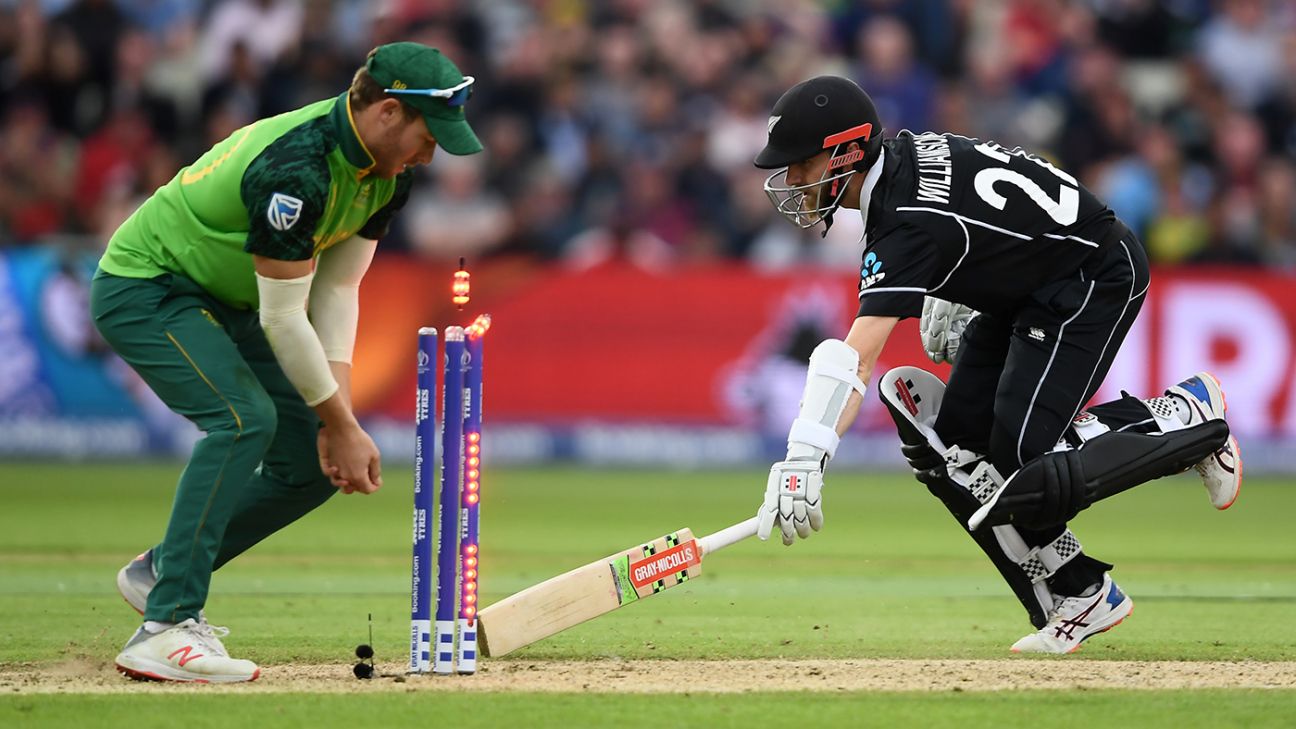
David Miller is avoiding stares. He stands half-bent at the non-strikers' end, flashing bail by his right boot. The opposition's key batsman puffing a few metres away. Kane Williamson should be heading towards the dressing room. He should have been run out by half-a-metre. Instead mid-off picks up the ball that Miller had failed to catch before he broke the stumps. When there could have been celebrations, a hush.
It is likely the throw Miller was attempting to gather took an unfortunate bounce, but five overs before that, it had been him who swooped on a ball from midwicket and produced an off-target shy at the stumps. Had he hit, Colin de Grandhomme would have been out for 14. Two overs after that, de Grandhomme would have been out again had Miller held a half-chance to his left, leaping up from short midwicket - the batsman having miscued a shot off Imran Tahir.
Much later, when Miller sprints around from deep midwicket and fails to intercept yet another aerial shot from de Grandhomme, his quarry falling short, bouncing over him, and dribbling into the boundary, it almost seems as if the ball, having a mind of its own, is taunting him. Each time, the wicket slips through Miller's fingers, like a ghost.
How much can one fielder be haunted?
WATCH on Hotstar (India only) - South Africa's missed chances
****
In the 1992 World Cup, South Africa were vexed by the old rain rule. In the semi-final against England, they had needed 22 off 13 when the rains came. Then 22 off one ball when play resumed - that old rule removing the runs scored off the two cheapest overs in England's innings, from South Africa's target (there had been two maidens, on this occasion). The Duckworth-Lewis method was introduced following this farce, but 11 years later, South Africa would terrorise themselves with the very rule their torment had occasioned. Needing seven to progress to the semi-final off two balls in a rain-shortened match against Sri Lanka, Mark Boucher hit a six, then blocked out the final ball, believing that one fewer run than was actually required would see his team through.
In 1999, the infamous run out of Allan Donald lost South Africa the semi-final, at Edgbaston. In 2011, the run out of AB de Villiers ruined them in Mirpur.
In 2019, something new. Williamson batting on 76, his team still 70 runs out. Tahir bowling a hard-spun legbreak, the batsman flashing, ball thudding into wicketkeeper's gloves, bowler appealing. Tahir is animated, but Quinton de Kock is not, so captain Faf du Plessis barely considers the review.
A minute later, on television, the truth is revealed. On Ultra Edge, just the hint of a spike. Only a murmur, really. The rustle of leaves on a windless night. A billowing of curtains. Williamson later tells du Plessis he didn't feel it on his bat. A batting poltergeist.
What next? If at the next World Cup, matches are played on covered grounds, will a South Africa batsman be denied a potentially match-winning six by the stadium roof, have that delivery be deemed a dead ball, then hole out immediately after?
How much can one team be haunted?
ALSO READ: Masterful Williamson keeps calm and carries on
****
Already in this campaign, South Africa had been hounded by history. Where in that 1999 semi-final Shane Warne had bedevilled them, bowling Herschelle Gibbs and Gary Kirsten with legbreaks that leapt out of Edgbaston footmarks on his way to that transcendental 4 for 29, in Southampton 2019, Yuzvendra Chahal claimed a four-for of his own. A legspinner, plus the spectre of legspin against them, another South Africa top order, devastated.
Now, three times in three tournaments, New Zealand have been their vanquishers. In 2011 in Mirpur, New Zealand doggedly defended a middling score, setting in motion a harrowing collapse. In 2015, Grant Elliott was dropped when JP Duminy and Farhaan Behardien collided in the outfield, when either of them could comfortably have taken that catch. Later, Elliott thumped the six to seal that game, off a poorly-conceived length ball, with the smallest boundary in cricket to defend. In 2019, after events had contrived to keep the match alive into the final over, after the key batsman could have been out twice, Williamson thumped another, effectively secure this one, off a poorly-conceived cutter, after South Africa's quicks had already delivered a predictable series of slower balls to him at the death.
Ghosts at Edgbaston. Ghosts from New Zealand. Wristspinning ghosts. Botched rain-rule scenarios, brainless run outs, dropped bats, dropped catches, contrived collapses, a missed DRS review, each footfall raising new spirits, another trauma to be thrown atop a swaying pile, all of this raising the question whether it will it ever happen for them, because how much really can South Africa be haunted?
Tagged under
Penultimate-over boundary was a bonus for Williamson
Published in
Cricket
Wednesday, 19 June 2019 18:24
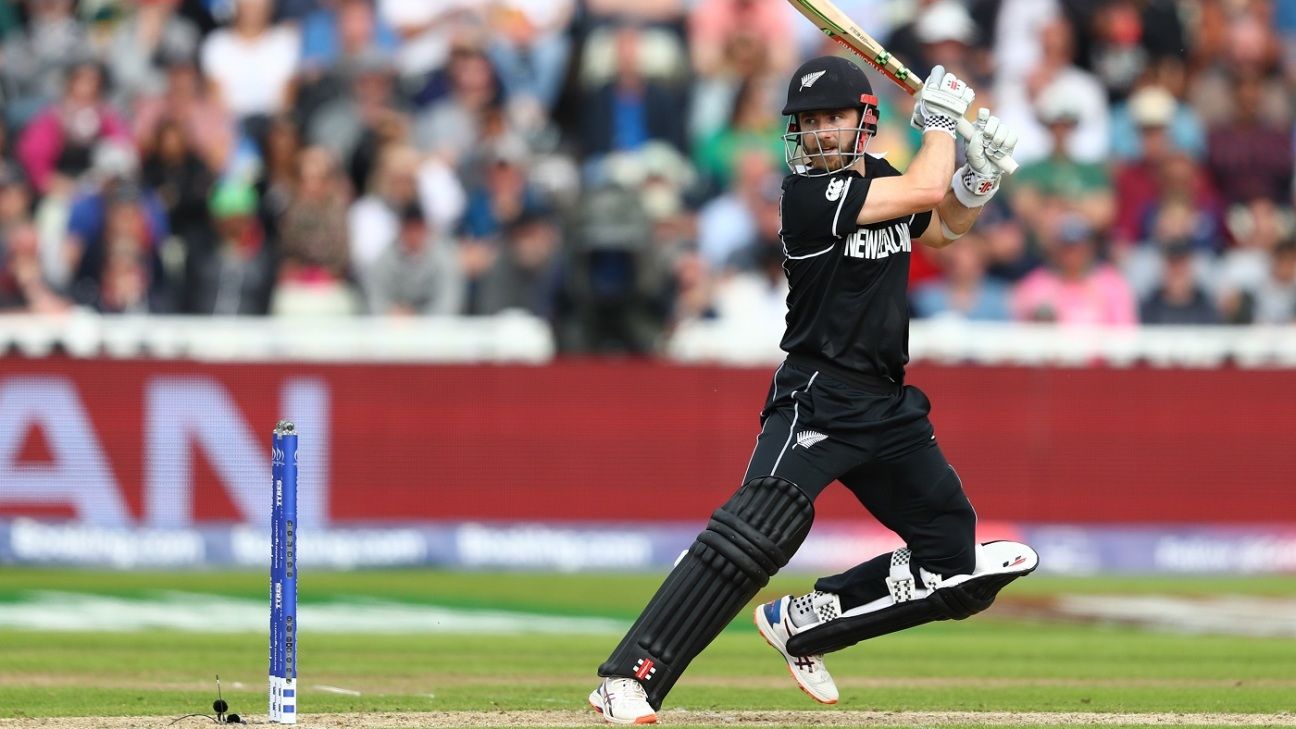
Sealed it with a dab. It is an unlikely end to a story of a thrilling match that is a throwback to eras gone by. New Zealand need 12 off seven balls. Kane Williamson opens the face to a slower ball, places it fine of short third man, gets four for it and kills the game off just when South Africa have started to dream again with just five runs and one wicket off the previous 11 balls. This boundary seems like just the Williamson thing to do, but the man himself was candid enough to acknowledge this was not the plan.
"Yeah, I was just looking for a single, to be honest, and then at the last minute I…" Williamson said to suggest he changed the shot at the last moment to place it fine of the short third-man fielder.
"No, no, I didn't," Williamson admitted to loud laughter from the press conference. International sports press conferences can be pretty banal, with New Zealand players - Williamson included - actually mastering the art of speaking a lot without saying anything. On this night, though, Williamson was in a playful mood after having scored a brilliantly calculated hundred to take New Zealand to a win against South Africa and virtually guarantee them a spot in the semi-finals.
WATCH on Hotstar (India only) - Williamson guides New Zealand home
"No, I was just looking for a single and to try to get down the other end, obviously, the shorter side [on the leg side]," Williamson said. "South Africa were having to bowl their fifth bowler [in the last over]. So it was nice it rolled away for four, definitely."
Williamson was asked about the period when he kept hitting balls straight to fielders, and his response was: "Those ones were coming out of the middle too, which was seemingly enjoyable but couldn't get any runs out of it." He was reminded of the times he got frustrated and swung his bat around, and he reminded the reporters of how many times he was hit on the arm: three times. "Once it [the bat] slipped, and it looked like [I was swinging it in frustration]. Yeah, it didn't have the anger behind it, but it did fall out."
This is not the Williamson you see at press conferences. This must have been a special innings although he didn't get into comparing it with his other knocks. He still didn't reveal many secrets about the chase, but he spoke enough the challenges on a slow, two-paced pitch.
"If you're bowling those straight lines it's difficult to hit across the ball when it is standing up in the wicket," Williamson said of the period when he struggled to find any gaps. "So you're trying to play straight, hoping that perhaps you pierce a few. But on those sorts of surfaces, when you're trying to weigh up the chase, it wasn't all that important that you weren't getting runs for them."
ALSO READ: Masterful Williamson keeps calm and carries on
That was the important part of the chase. Trying to not let the frustration get the better of him when all South Africa needed was one indiscretion from him to give them his wicket. "You always feel," Williamson said when asked if he does feel the tension at certain times and if he has any routines to get out of it. "Some days it's free-flowing and you don't have to perhaps negotiate as much as other days. And then, it's a little bit different if you're chasing a higher score perhaps on a better surface and you are required to perhaps push it at different stages.
"But with the total we were chasing, albeit on a tough surface, it meant that it doesn't have to be right here right now, which I guess is sometimes the thing that can cloud you. And if you're able to communicate with your partner, hopefully, that can help with decision-making. And at the end of the day, you're just wanting to make the best decisions you can despite at times struggling through different periods of an innings."
This was only the second close game out of 25 in this bloated World Cup. Both have involved New Zealand. Williamson believes the experience of having come on the right side of those will help them later in the tournament. "There's a huge amount to learn from this performance," he said. "The experiences that you have by being put under pressure on a number of different occasions, whether it's with the bat or the ball, having close games in tournaments like the World Cup are great to be a part of, especially when you come out on the right side of things.
"We also know that we've got a number of games left on different surfaces. We'll be back here [in Birmingham, for another league match and a possible semi-final] again at some point. We won't know the difference that will hold for us, but we'll also have Manchester [which will also host one of the semi-finals], where we go next, and once again, I know that's been playing well. We'll just have to adapt and keep playing the sort of cricket that gives us the best opportunity to win cricket games, but day in, day out, that can vary a lot depending on opposition and surfaces."
Tagged under
'We left everything out there, that's all I can ask' - du Plessis
Published in
Cricket
Wednesday, 19 June 2019 19:08
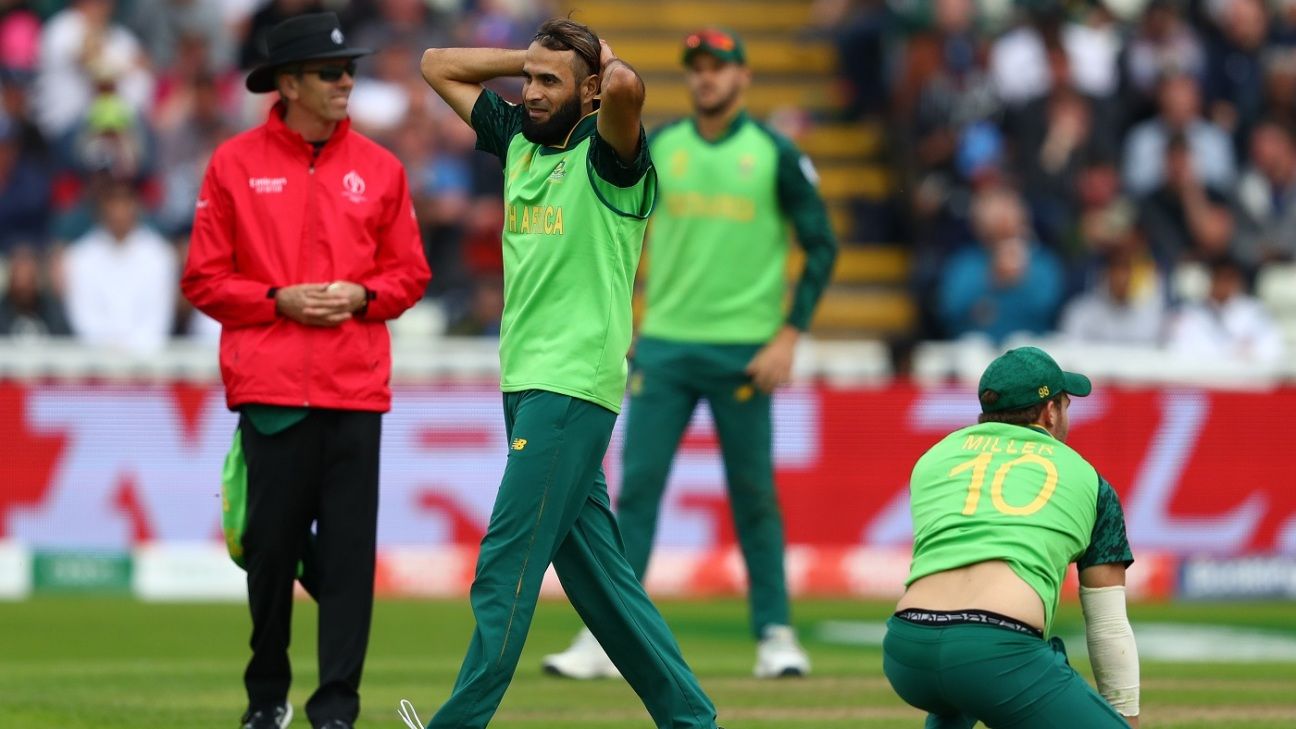
Statistically, South Africa are not out of the tournament yet. But Faf du Plessis realises it would take a near miraculous set of circumstances to put them in the semi-finals. Not only would they have to win each of their three remaining games - probably by gigantic margins - but a host of other results, rain-abandonments included, would have to go their way.
"You know, it's tough now," du Plessis said after the loss to New Zealand. "You can feel in the dressing room the guys are hurting. I'm feeling five years older. My body is really sore after that. So we left everything out there, and that's all I can ask for as a captain, that the guys fought. They showed that.
"Unfortunately, we've just not been as good as the opposition that we've played against. New Zealand today was a little bit better than us. That's a skill thing - not a hunger thing. That's not a determination thing. That's not a fight thing. So I can't fault the team for that."
So where did South Africa go wrong? Tough catches were dropped, and run outs were missed, during their defence of 242. But it was the batting that truly let itself down, as has been the case right through the tournament, he said. South Africa's top score in their four completed matches so far is Quinton de Kock's 68 in the tournament opener against England.
ALSO READ: The haunted history of South Africa's World Cups
"We batted through a tough time getting partnerships together, then we lose a wicket, then we batted again and got the partnership together - it was a lot of stop-start. With that, you lose out on 15, 20 runs, and that's what we were saying in the dressing room the whole time. We were trying to get to 260 or 270. That would be a really good score.
"We did well in parts today. The wicket wasn't as flat as you would have thought it would be. Those first 15 overs felt exactly like Auckland - the ball was hooping around corners there. So we felt like we did the hard work, and we thought it would be easy after that, but they kept getting a wicket every time there was a 50 or 60-run partnership. You need that to go to 100, and you need one guy to bat through the innings. You need someone to get 100 plus, and that gives you that 15, 20 more runs."
"When I speak about putting your hand up and putting performances in, I point my finger as us as a unit. Certainly, I need to be the leading run scorer in our batting unit with Quinton de Kock probably."
South Africa have three more matches to play in the tournament, but as they are essentially now out of contention for the knockouts, thoughts will begin to turn to building for the next World Cup. Imran Tahir - their best ODI spinner ever - had already announced that he would retire after this tournament. There are several other players, du Plessis included, who may be fighting to get through the next four years, in order to compete in the World Cup in India. Du Plessis' captaincy will also be under scrutiny.
"You're probably got three or four guys getting away from the ODI team, with quite a few guys getting to the end of their careers," du Plessis said. "Depending on cricket South Africa - in terms of what they believe is a good way forward - they might want a complete change.
"But those are things you sit down and talk about. We've got some young players, so there's a future there. The young guys, I've really backed them this tournament. I think they've got a great future ahead of them. Rassie van der Dussen has shown that he's the real deal. I think he's got leadership capabilities as well. He's standing up to be a strong man in a big tournament for us. Andile Phehlukwayo has done well as a young guy. Aiden Markram - we know the kind of player he is. He showed signs today that he can do it.
"What will naturally happen is you'll probably lose six or seven players after this tournament. Whether you want to change more than that - no, I don't think you need to do more than that."
Tagged under
CWS quiets Vandy's whistler amid complaints
Published in
Breaking News
Wednesday, 19 June 2019 19:19

OMAHA, Neb. -- Before Preacher Franklin packed his scooter and headed out to Wednesday's College World Series, his wife had one plea: don't get thrown out.
Franklin is known as the Vandy whistler, and if you watch enough college baseball games, you might be familiar with his work. His loud, chirpy whistles reverberate throughout southern ballparks, annoying opponents and TV audiences alike. On Sunday, during Vanderbilt's opening-round game against Louisville, Franklin said he was approached by a TD Ameritrade Park official and told to stop whistling or risk being thrown out.
Franklin, 72, has been whistling at various Vanderbilt sporting events for about 15 years. He said Sunday marked the first time that he has been ordered to stop.
For the past couple of days, he was conflicted over what he should do for the rest of the CWS. He drove his van, tricked out in Vandy colors, 780 miles from his home in Smyrna, Tennessee, to Omaha to root on his team. He did not want to watch from his hotel room.
"Legally, I don't see how they can shut me up," he said before Wednesday's game between the Commodores and Mississippi State. "They're making their own rules as they go. I think they ought to leave me alone.
"I have a lawyer that called me. He's a friend of mine. He says, 'Go on and whistle. If they throw you out, we'll sue 'em.' I said, 'I don't know, man. I want to watch the game.'"
Kristyna Engdahl, director of communications for MECA, which manages TD Ameritrade Park, said that Franklin was approached after "an onslaught" of guest complaints both inside and outside the stadium. She also said there were a number of calls and emails from people unhappy with the whistler. Ballpark policy, Engdahl said, prohibits disruptive noisemaking of any kind.
Several Louisville players interviewed Wednesday said they weren't bothered by the whistling from Sunday's game because they are trained to lock in and tune out any outside noise.
But if Vandy continues its run at the College World Series, it might get even louder. The team actually has two whistlers. The other one, Jeff Pack, was hoping to get to Omaha this weekend, according to his wife, Karen.
Pack is a hardcore fan, too. He and his wife rescued two cats, who are black with gold eyes, matching Vanderbilt's school colors. They named them Franklin, after the former Vandy football coach, and Corbin, after current baseball coach Tim Corbin.
Preacher Franklin is somewhat of a celebrity at Vanderbilt games, frequently getting stopped to pose for pictures. He said he meant to behave Wednesday, but just before the game, he couldn't help himself. He chirped and then started to show off, imitating a police whistle.
But for the most part, he picked his spots. He whistled just before Vandy outfielder J.J. Bleday's at-bat in the fifth inning, and Bleday promptly doubled to deep center, putting the Commodores up 2-0. Though Franklin sat near the concourse, his whistles could be heard all the way up in the press box.
At one point during the game, the same stadium supervisor from Sunday approached him again and gave him one warning.
It was hard to do much else, though, because at least three other Vandy fans seated by Franklin started whistling too. They told him they had his back.
Franklin said he came to sort of an understanding with the stadium official. He'd only whistle when Vanderbilt did something good. The way the Commodores played Wednesday in their 6-3 victory, he might be whistling all weekend.
"We were happy to work with him," Engdahl said. "I think our goal was to find a happy medium, and I think we left today feeling like we did."
Tagged under
L.A. track coach charged with abusing ex-athlete
Published in
Breaking News
Wednesday, 19 June 2019 18:16
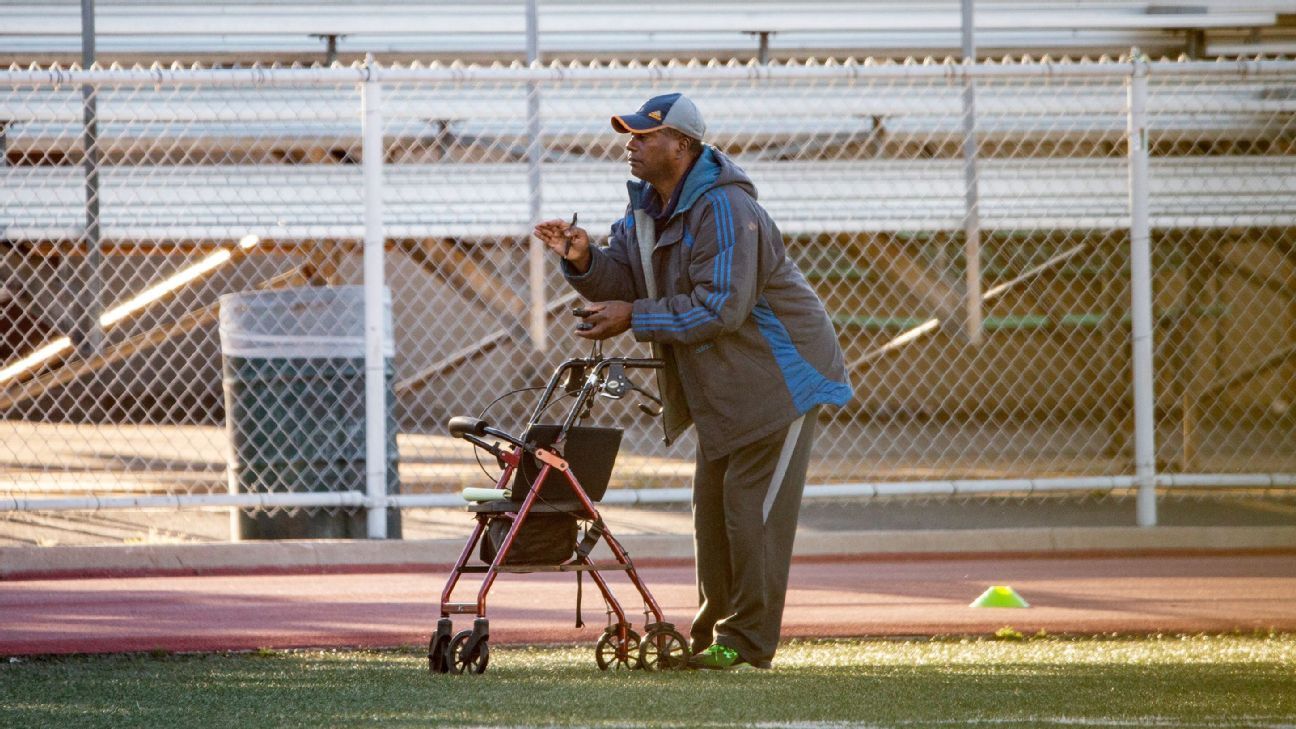
LOS ANGELES -- Police on Wednesday arrested a one-time Olympian and longtime track coach on charges of molesting a former athlete -- one of nearly three dozen men who told Outside the Lines the coach sexually abused them over the past 44 years.
Conrad Avondale Mainwaring, 67, has been charged with one felony count of sexual battery by fraud, which is punishable by up to four years in prison. When approached by Outside the Lines recently at a Los Angeles-area track, Mainwaring declined to answer questions about the men's allegations. He also did not respond to several other interview requests.
An ongoing Outside the Lines investigation has uncovered a pattern of allegations against Mainwaring dating from the mid-1970s to as recently as 2016. Some of the earliest alleged victims were teenagers -- the youngest was 14 -- at a New England summer camp. Others attended universities in at least three other states, including, most recently, California.
Thirty-one men -- 16 of whom agreed to be named -- described similar methods of abuse. They described Mainwaring using his Olympic credentials and relationships with accomplished athletes and expertise in psychology and physiology to persuade boys and young men to train with him. They said he initiated sexual contact under the guise of mental training that focused on getting them to control and manipulate erections and testosterone levels as a means of improving athletic performance.
The specific Los Angeles charge was precipitated by the Outside the Lines investigation. Over the past year, as word spread among victims about the reporting, a 22-year-old Southern California man contacted an ESPN journalist with his story of alleged abuse. The man said he was 20 at the time and a college student when he trained with Mainwaring. After the interview, the journalist referred him to Los Angeles Police Department detectives, who already had begun looking into Mainwaring on tips from out of state.
Virtually all of the alleged victims said Mainwaring convinced them that none of the acts was sexual, rather that they were "all clinical" and designed to make them superior athletes. One recalled Mainwaring telling him, "You can be an Olympian too, you know. You can get to this level."
LAPD detective Sharlene Johnson said Mainwaring was "using his position as a coach with athletes who are so focused and driven to be perfect at their craft that he was able to victimize them without them even realizing it."
Johnson said she was struck over the course of the police investigation that Mainwaring was able to avoid scrutiny for so many years. Among the challenges: The statute of limitations had expired by the time many of the alleged victims decided to go public.
The alleged victim in the LAPD case said Mainwaring administered what he called therapy to help the man's performance as a runner in 2016. The treatment included massage and manipulation of the man's genitals, an account that mirrors those of the other men interviewed by Outside the Lines.
Mainwaring competed at the 1976 Olympics for the Caribbean nation of Antigua, now Antigua-Barbuda, where he was born. Later, he helped coach Dominican-born hurdler Felix Sanchez to Olympic gold medals at Athens in 2004 and London in 2012. Sanchez is not among Mainwaring's accusers; he could not be reached for comment, but he said through a friend that he knew nothing of any inappropriate behavior by his former coach.
The reporting indicates the first allegations stemmed from about 1975 in England -- where Mainwaring grew up -- and continued over the next few years when he worked as a summer camp counselor in the United States. Over the following four decades, dozens of men allege, Mainwaring molested them at or near several American universities.
There is no record that Mainwaring was employed by the athletic departments at any of the schools, but in at least three cases, he worked in other parts of the universities, including student housing, disability services and admissions. In many cases, he was a recognized regular at the schools' tracks.
Throughout the course of its investigation, Outside the Lines learned that Mainwaring was reported to law enforcement agencies and employers in England and the United States, but there is no record he was ever charged with a crime until now.
Mike Kessler is the investigative editor at KPCC, a National Public Radio affiliate in Los Angeles. Reach the reporters at This email address is being protected from spambots. You need JavaScript enabled to view it. and This email address is being protected from spambots. You need JavaScript enabled to view it.. Greg Amante, a producer in ESPN's enterprise and investigative unit, and Tonya Malinowksi, an associate producer for Outside the Lines and E:60, contributed to this report.
Tagged under
Reports: 'Space Jam 2' cast to include AD, CP3
Published in
Basketball
Wednesday, 19 June 2019 19:54
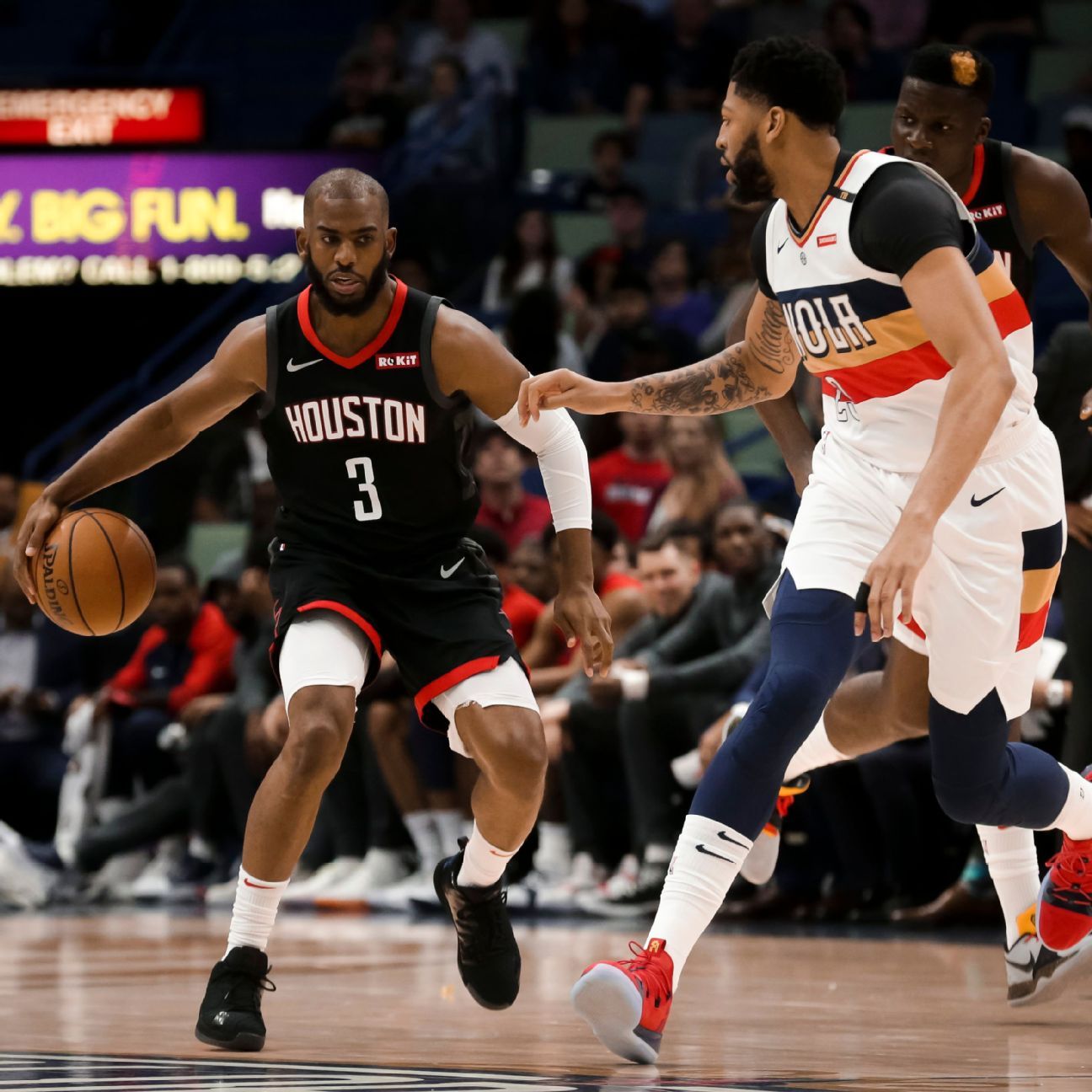
The cast of "Space Jam 2," which will star LeBron James, will include his new teammate, Anthony Davis, as well as Portland star Damian Lillard, Warriors swingman Klay Thompson, and James' Banana Boat pal, Chris Paul, according to multiple reports.
WNBA great Diana Taurasi will also have a role in the film, as will the Ogwumike sisters, Nneka and Chiney, who play for the Los Angeles Sparks, according to the reports.
The cast was first reported by LakeShowWorld.com.
In September, James announced that Black Panther director Ryan Coogler would produce and Random Acts of Flyness creator Terence Nance would direct.
James and longtime business partner Maverick Carter had been in talks to make a "Space Jam" flick for more than five years. The film is a remake of the 1996 box-office smash that starred Michael Jordan and Bugs Bunny.
Filming was expected to start during the 2019 NBA offseason.
Tagged under

Their relationship was anything but a bromance during Fay Vincent's three years as the commissioner of baseball and there hasn't been a rapprochement since. But Wednesday, when asked by ESPN's Outside the Lines about the Chicago White Sox plan to extend safety netting to the foul poles, Vincent expressed unqualified support for the initiative of team chairman Jerry Reinsdorf.
"Jerry is very smart -- I don't often agree with him, but he's right." Added Vincent: "He is a lawyer, he is careful and he is very wise."
Vincent, also a lawyer, weighed in on the future of the rule on which Major League Baseball has relied for decades against liability lawsuits over fan injuries. Since 1913, every ticket to a major league game has contained a disclaimer saying the holder of the ticket assumes all the risks inherent to the game. Called "the Baseball Rule," it has made it nearly impossible for fans injured at games to successfully sue teams or MLB.
"The future of tort law is in favor of more safety, more reasonable protections," Vincent said. "Could I see a court overturning the 'Baseball Rule'? Assumption of risk doctrines have been cut away."
Vincent said he doesn't recall having any serious discussions of netting extensions during his tenure from 1989 to 1992, but he shared two other stories from the '90s.
Shortly after Atlanta's Turner Field opened, Vincent said, he was with longtime Braves owner Ted Turner, who asked him if he thought the owner's box needed protection. As Vincent and Turner chatted on the field, Turner's then-wife Jane Fonda was in the box. Vincent recalls looking in that direction and telling Turner the box was dangerously close to the action and that safety measures were warranted or someone could get killed.
As Vincent recounts, Turner described Vincent's conclusion as "B.S." and added that seeing the game through vinyl netting or plastic would be "like having sex with a condom."
"I said, it's to save your life," Vincent said.
At the 1991 World Series between the Twins and Braves, Vincent said, he, his daughter and American League President Bobby Brown were among those in the commissioner's box when a foul ball was hit toward them. Brown, a former eight-year major league player, had a glove with him and as the foul approached, he placed it face down atop his head and ducked.
Then Vincent's daughter, 23, got hit on top of her head by the ball and had to be taken for first aid treatment. She returned to her seat after about 30 minutes, but she had the imprint of the ball's seams on her head. And before she could identify herself on a visit to a physician the next day in Massachusetts, the doctor said he'd watched the game on TV and saw the commissioner's daughter get hit. She confirmed it was her.
As for how current commissioner Rob Manfred might best proceed to convince all MLB owners to follow Reinsdorf's lead and commit to netting extensions to the foul poles, Vincent said, "He could say to them, 'I encourage you to do it, I could order it, but I'd rather you do it on your own.'"
Said the former commissioner: "The fewer things you have to require as commissioner, the better."
Tagged under
Sabathia hits 250-win milestone: 'It's a big deal'
Published in
Baseball
Wednesday, 19 June 2019 17:06
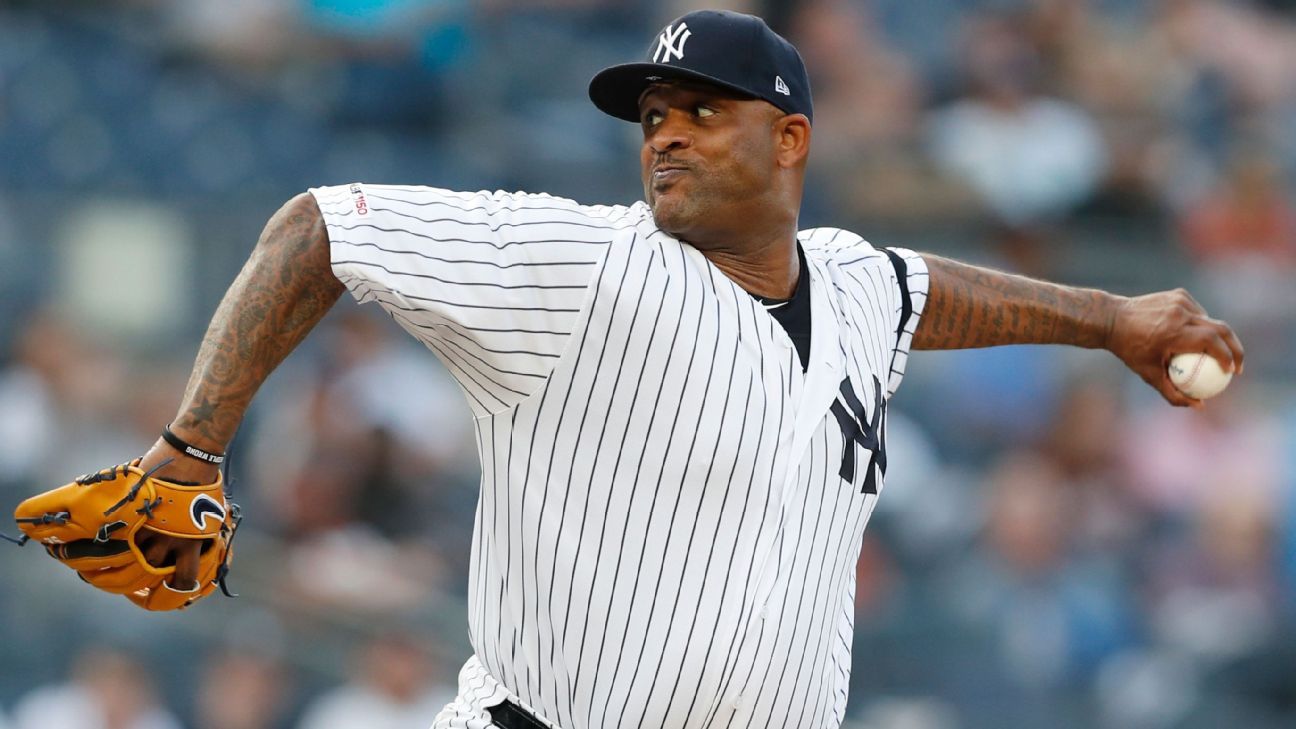
NEW YORK -- CC Sabathia, pitching in the final year of his illustrious major league career, keeps hitting milestones.
This time it was a wins mark: 250 of them, to be exact.
Seven weeks after becoming the 17th pitcher in big-league history to record 3,000 strikeouts, Sabathia added his name Wednesday to the list of 48 pitchers to have registered 250 wins in a career.
"It's crazy to put my name up there with some of those guys that I idolize, and some of those names that are enshrined in baseball history," Sabathia said. "To be part of that, it's a big deal."
Sabathia accomplished that "big deal" in somewhat smooth fashion, lasting six comfortable innings by striking out seven in a one-run three-hitter as his New York Yankees blew out the division-rival Tampa Bay Rays, 12-1.
The win locked up a series sweep for the Yankees, extending their American League East lead over second-place Tampa Bay to 3½ games. New York also has now taken seven of the nine games the teams have played.
Even on such a momentous day, Sabathia didn't lose sight of the importance of the midseason win. In fact, when first asked what win No. 250 meant to him, he offered this reply: "Just another win for us; a sweep against a very good team. We wanted to keep it rolling."
With a six-run first inning by the Yankees, it didn't take long for the historic win to start coming into view. Still, Sabathia said his mind was on making sure he kept getting the game back in his offense's hands as quickly as possible so it could do even more damage.
"That's a great lineup, a great team," he said of a Rays club he has gotten into verbal spats with during recent starts, due to his teammates either being thrown at or hit by pitches. "I'm still focused on trying to get the team back in the dugout to score more runs. Let's have a quick inning, and get back in the dugout and try to put some more pressure on their pitchers." The first-inning outburst was one of two the Yankees had in the lopsided victory. They added a six-run seventh for added insurance.
Sabathia is now the 14th pitcher in baseball history with both 250 wins and 3,000 strikeouts. All but one of the previous 13 are in the Hall of Fame. Roger Clemens is the lone pitcher on that list who hasn't yet been voted in.
"This is a sport that goes back a long, long ways, and those are numbers that more so than any other sport, mean something, and speak to his greatness and his longevity," said Aaron Boone, the Yankees' current manager who also played with Sabathia earlier in his career.
Additionally, Sabathia has become only the third left-handed pitcher to hit both marks, joining Hall of Famers Steve Carlton and Randy Johnson. He's also just the third African American pitcher to have a 250-win, 3,000-strikeout career, joining Bob Gibson and the Canadian-born Ferguson Jenkins.
"That means a lot, being an African American pitcher, being from the inner city, and wanting this game to grow and getting back in the inner city," Sabathia said. "Having a chance to put up these numbers and let some of these kids know that I'm from where they're from, and I love this game of baseball, hopefully it'll open some doors for some kids and open their eyes to start playing the game."
Much of Sabathia's success Wednesday hinged on his ability to throw strikes with a pitch that he had been struggling with in recent starts: his cut fastball. It was after his previous outing at the Chicago White Sox when Sabathia said he had trouble finding the grip on the pitch that, of late, has kept his career alive and thriving.
In a 4⅔-inning outing in Chicago on Friday, Sabathia allowed 10 hits and six runs in a Yankees loss. The cutter just wasn't being located the way the lefty had hoped it would be.
"In between starts, I sat with the baseball the whole time, and just played with my thumb on the ball, and tried to figure out a good, comfortable spot to move my thumb to get that good feel of where I was able to get the ball to cut," Sabathia said.
All of that time sitting with a baseball, coupled with what he felt was a strong bullpen session this past Monday, led to his dominant milestone outing.
"It's an honor to somehow be involved in his history," catcher Gary Sanchez said through an interpreter. Sanchez also was behind the plate in April when Sabathia notched career strikeout 3,000 in a loss at Arizona.
Sabathia's current 3,043 strikeouts are well beyond the 2,813 and 2,117 totals that this year's Hall of Fame starting pitching inductees, Mike Mussina and Roy Halladay, had. The duo is entering Cooperstown alongside former Yankees closer Mariano Rivera, a pitcher who Sabathia acknowledged Wednesday.
It was during spring training of 2014 when Rivera and another former Yankee, southpaw starter Andy Pettitte taught Sabathia how to throw the cutter that has helped resurrect his career.
At the time, knee troubles, age and a loss of velocity were forcing the longtime power pitcher to reinvent himself. Finesse and control became the new name of Sabathia's game.
"If I hadn't learned that pitch in 2014, I probably would be out of the game," Sabathia said. "So to have those two being willing to help me and willing to tutor me means a lot."
Sabathia, whose first big-league win came in Detroit in April 13, 2001, has long said reaching win No. 250 wasn't very important to him. He'd rather have crossed the 3,000-strikeout plateau.
"I really did mean that," Sabathia said. "I just want to go out and pitch well and help this team win games.
"To get a win, so many things have to go right. I feel like strikeouts is kind of you. It's a team win more than it is yourself. One of those things I feel like, when the team wins or when I win a game, it's because of everybody else."
Ever the consummate teammate, Sabathia, whether in Cleveland, Milwaukee or New York, has been lauded over the years by the people who have played with him. Yankees shortstop Didi Gregorius explained why.
"The guy has been in the game for 19 years and he always battles and goes out and gives it his heart," Gregorius said. "He's one of the kind of pitchers you want to go out there and see pitch every day, and he's a great leader here in the clubhouse and guys love him."
Tagged under

SANTO DOMINGO, Dominican Republic -- Former Red Sox slugger David Ortiz was shot in the back by a gunman who mistook him for the real target, another man who was seated at the same table at an outdoor cafe, Dominican officials said Wednesday.
The Dominican Republic's attorney general and national police director told reporters that the attempted murder was ordered from the United States by Victor Hugo Gomez, an associate of Mexico's Gulf Cartel. They said Gomez had hired a gang of killers to eliminate his cousin, whom Gomez suspected of turning him in to Dominican drug investigators in 2011.
The cousin, Sixto David Fernandez, was seated with the former baseball star on the night of June 9, when a gunman approached and fired a single shot at Ortiz, the officials said. Fernandez owned an auto-repair shop and was friends with Ortiz, according to Attorney General Jean Alain Rodriguez and Maj. Gen. Ney Aldrin Bautista Almonte, director of the Dominican Republic's national police.
Ortiz remains hospitalized in Boston, where doctors have upgraded his condition from guarded to good.
At least 11 people have been arrested in the case so far, ranging from the alleged gunman to a series of drivers and relatively minor accomplices. Rodriguez and Bautista said the case of mistaken identity began when one of the accomplices shot a blurry photo of Fernandez seated at the Dial Bar and Lounge in an upscale section of Santo Domingo. In the photo, a white freezer obscures Fernandez's lower body, making it look like he was wearing white pants when, in fact, he was wearing black pants, officials said.
"It was a badly lit photo taken minutes before the attack," the chief prosecutor said.
Ortiz was wearing white pants on the night of the shooting and law-enforcement officials said that the gunman, Rolfy Ferreyra, mistook him for the target and fired.
Nonetheless, many Dominicans were skeptical that their country's most famous person, a 6-foot-3-inch man weighing around 250 pounds, could be mistaken for Fernandez, who appeared to be far smaller with a lighter complexion in a photo provided by authorities.
"He is big. He likes to attract attention," said Daniel Pou, an independent consultant on public security. "He wears a lot of jewelry. He's flashy all around."
The alleged shooter is a skinny, tattooed 25-year-old whom U.S. prosecutors said is wanted on armed robbery and gun charges in New Jersey. His driver was captured immediately after the shooting when he fell off the motorcycle he was trying to use to escape.
Ferreyra and the other suspects were captured over the next few days. Ferreyra told reporters from the window of a jail cell this week that he did not mean to shoot Ortiz, but fired at him in confusion over his clothing.
Gomez, the alleged mastermind, is believed to be in the United States and is being sought by the Drug Enforcement Administration, Bautista said, pointing to a news report in which federal authorities identified Gomez as one of several suspects in a March 2019 drug trafficking sting in Houston, Texas.
The weapon used in the shooting, a Browning Hi Power semiautomatic pistol, was buried in the garden of one of the suspect's home and was later turned over to police by his mother, according to court documents obtained by The Associated Press.
Also accused is Gabriel Alexander Perez Vizcaino, aka Bone, whom they say was hired by someone who is in prison on unrelated charges to be the liaison between the hit men and the person who paid them. Authorities say Perez shared the picture of the target as he met the other suspects at a nearby gas station just minutes before the shooting.
They said Perez then sold the cellphone used to plan the attack and to distribute a picture of the target to a woman for $180 so he could get rid of the evidence a day after the shooting.
Police are still looking for at least three other suspects: a woman known as The Venezuelan or Red; Luis Alfredo Rivas Clase, aka The Surgeon, who is wanted for a 2018 shooting in Reading, Pennsylvania, and was believed to be driving a car used to stalk Fernandez; and Alberto Miguel Rodriguez Mota, whom authorities believe paid the hit men. Authorities have said coordinator of attack was offered 400,000 Dominican pesos, or about $7,800.
A video from the scene of the shooting shows everyone fleeing or crouching except for Rodriguez, who stands calmly amid the chaos.
"He grabbed his beer to make sure it was safe," Bautista said.
Authorities also are investigating Fernandez, the supposed target, Bautista added.
Ortiz is recovering at Massachusetts General Hospital. Doctors in the Dominican Republic removed his gallbladder and part of his intestine before he was wheeled into an air ambulance sent by the Red Sox and flown to Boston.
He led the Red Sox to three World Series championships, was a 10-time All Star and hit 541 home runs. The Red Sox retired his number, 34, in 2017, and he has a bridge and a stretch of road outside Fenway Park named after him. He has a home in Weston, on the outskirts of Boston, that he shared with his wife and three children before putting it up for sale.
Although he lives in Boston, the 43-year-old Ortiz visits the Dominican Republic several times a year. His father and sister live in Santo Domingo.
Tagged under















 Phone: (800) 737. 6040
Phone: (800) 737. 6040 Fax: (800) 825 5558
Fax: (800) 825 5558 Website:
Website:  Email:
Email: 






